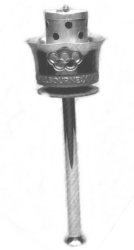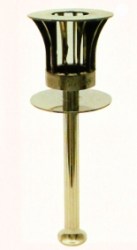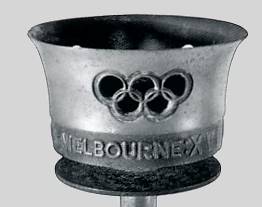Torch and Torch Relay
| The Torch Relay 1956
The Olympic Games are indelibly associated with Greece, the country of their origin. This association is acknowledged on each Opening Day by giving premier position to the Greek team, and also by the ceremonial raising of their flag to the playing of their National Anthem. To these tributes from 1936 has been added a further link by bringing from Olympia, the birth-place of the Games, a flame to kindle the cauldron in the Main Stadium. On ists first journey to the Southern Hemisphere the plan accepted was to carry the flame by runners from Olympia, in Elis, to Athens whence Qantas Airlines would give it safe passage to Darwin, its first stop in Australia. A Royal Australian Air Force plane would carry it across the north of the continent to Cairns, on the north-east cost, which ws to be the starting point in Australia of a relay of 2,830 runners who would carry it day and night to arrive at the Main Stadium at 4.32 on the ofternoon of 22nd November. Cairns had been chosen as the starting point of the Australian relay, as the route would then pass through two of the State capitals, Brisbane and Sydney, and also the Federal capital, Canberra. The relay was planned in reverse, from point and time of arrival, which, with the place of kindling, were the only three known factors. From these, through months of patient planning and international co-operation, the details of the journey of the flame gradually took form. The planning of the first stage from Olympia to Athens was the simplest for the Organizing Committee due to the co-operation of the Hellenic Olympic Committee, who accepted the responsibility of arranging the ceremonial kindling and the relay of 350 runners to Athens. At 9.30 on the morning of 2nd November at
Olympia, in the north-west of Pelopponese, the historic ceremony took place.
A torch was held in the hot spot of a parabolic reflector. After the torch
flared it was placed in an urn and carried from the Stadium by the Vestal
Virgin of the Temple of the Olympian Jupiter, attended by three priestesses,
who, in procession, approached the Temple of Hera, where the urn enshrining
the flame was set on the altar. The first runner holding a torch then appeared,
ran to the altar, where he knelt while the Priestess lit his torch and
handed it back to start on the first stage of its 350 kilometres journey
to the Acropolis, in Athens. Here, as the last runner reached the entrance,
the way was barred by two soldiers in the uniform of Marathon Warriors.
The runner raised his torch with the cry " I am bringing the Flame of Olympia
", and at once was allowed to enter. As he ascended the sacred rock a choir
of hundreds of students sang the Olympic Hymn of Samaras as an invocation
to the immortal Greek spirit to bless the flame. After the ritual, the
torch was handed to the President of the Hellenic Olympic Committee who
transferred the flame to the Miner's Lamp (presented by the Saar Olympic
Committee), which was then handed by His Royal Highness the Crown Prince
Constantine of Greece to the Australian Consul-General (Mr. J. J. B. Cliffe).
It is estimated that at least 6,000 people witnessed the Ceremony. The Miner's Lamp was then taken by car to
Athens Airport where it was formally handed over to Qantas at mid-day on
Saturday, 3rd November. A last-minute alteration in schedule had to be
made and the flame remained overnight at Athens and departed at 7 a.m.
on the 4th. The plane also carried 200 kilograms of philatelic mail. During
the journey, large receptions were held at Calcutta, Bangkok, Singapore,
Djakarta and at Darwin, its first landing in Australia, where it arrived
in the evening of the After a civic reception at Darwin, the flame was carried 909 miles to Cairns by a Canberra jet bomber of the Royal Australian Air Force. Heavy rain and low-lying clouds had raised doubts whether the bomber would be able to land, and it was a tense group of people who waited at the Airport. While it was still above the clouds the whine of the aircraft engines was recognized, and then suddenly to everyone's relief it appeared on the runway. The flame had arrived. The Miner's Lamp was carried past the Guard of Honour and handed over to the Mayor of Cairns (Alderman W. J. Fulton), who uncovered the minute Olympic flame, and with a taper lighted the torch for the first runner, an Australian-born Greek, who set out on the first stage at 1.40 p.m. exactly on time. The second runner was an Australian aboriginal. |

|
| Description: | Cut-out rings above legend " MELBOURNE: XVI OLYMPIAD 1956" |
|---|---|
| Material: | Aluminum alloy; |
| Fuel:l | Hexamine in the form of tablets; |
| Torch measure: | Lenght: 47 cm Weight: 960 gr |
| Torches total: | 400 |
| Design by: | Ralph Lavers |
| Manufacturer: | |
| Date of the torch relay: | 2. November - 22. November 1956 |
| Duration: | 21 days |
| Numbers of runners: | 3,180 |
| Distance total: | 4.912 km |
| Name of the last runner: | Ronald William Clarke |
The flame was attended by a convoy of vehicles sent from Melbourne. This convoy comprised both civilian and Army vehicles. The civilian vehicles, lent by a leading motor manufacturer, were driven by students of Melbourne University under the direction of Mr. M. A. H. Marsden, who was responsible for the co-ordination of the convoy and Relay. The task of the convoy was to ensure that each runner was supplied with a torch and to collect it from him at the end of his mile. Each of the 110 torches purchased for the Australian section of the Relay had to be used many times, and two trucks were equipped as mobile workshops to service the torches. The convoy also carried the commemorative medals which were issued to each runner en route. The team travelling with the convoy, in addition to supplying and servicing torches, assisted at receptions, but had no responsibility for the organization of the runners. This had been planned quite separately and the route had been subdivided into four major sectors, namely :-
Sector.
Honorary Organizers. The first runner leaves Cairns Airport. The sectors were further subdivided for local organization. In view of the climatic conditions varying from tropical to temperate, the times allowed a mile were :-North Queensland-7 minutes, South Queensland-6½ minutes, New South Wales and Victoria-6 minutes. The Honorary Organizers had to measure and mark the route in their sectors into one-mile lengths. In some areas, the mile posts were already available, but long stretches had to be specially marked. |
| Country | Date | Distance | Runners | Torches |
|---|---|---|---|---|
| Greece | 02.11. - 03.11.1956 | 354 km | 350 | |
| Australian Airline Quantas |
04.11.1956 | - | ||
| Australia | 04.11. - 22.11.1956 | 4,558 km | 2,830 | |
| Total | 4,912 km | 3,180 | 400 |
With these mileage figures as a basis, the skeleton time schedule had been drawn up by calculating backwards. It was decided that the flame would have to arrive at Cairns Airport at 1 p.m. on Friday, 9th November and then be taken 4 miles to Cairns to leave at 2.39 p.m. on its journey of 2,830 miles, travelling day and night for 13 days, 1 hour, 53 minutes. The route was planned and timed to the minute. The selection of runners was no easy task as there was strong competition for inclusion. All branches of amateur sport were represented. As the Relay continued day and night, the convoy was divided into three parties. Each party remained with the flame for eight hours, then went ahead a suitable distance, and after eating and sleeping, was ready to resume duty as the flame caught up. In practice many difficulties arose, particularly in the areas of sparser population where accommodation was limited and some parties, particularly controlling staff, had little rest for several days at a time. Heavy traffic was always a hazard not only for the risk of accident but also for the possibility of the vehicles being separated from the torchbearer. This happened several times, but luckily caused no serious harm.
Every athlete was on his mark early and the front truck, running a mile or two ahead of the flame, was scheduled to arrive with five or ten minutes to spare. The attendant on the truck then checked the runner's identity, gave him a torch and instructed him how to light it from the preceding runner's torch. The flame arrived, was transferred, and the runner was off on his mile. On completion and after lighting the succeeding torch, the runner gave his torch to the attendant in the rear truck which had followed immediately behind him, and was then presented with a commemorative medal. The attendant, wearing asbestos gloves, doused the torch in a bucket of sand, removed the burnt fuel canister and set the torch to cool on the rack. As far as he was able, the rear truck attendant also cleaned and refuelled the empty torches and prepared them for further use. A strict watch had to be kept on the Miners' Lamps, each of which was kept in a separate truck in a spring-loaded housing to protect it over bad roads. The flames in the Miners' Lamps were carried throughout the Relay as a precaution against failure of the torch flame. However, they were not required. When the leading truck had exhausted its supply of torches the rear truck went ahead and continued the issue.
The convoy commander held a roving commission with the added duty of moving ahead when possible to towns where civic receptions were to be held, to finalize details and at the same time present commemorative medals to civic dignitaries in appreciation of the part they played in the organization of the Relay.
For several weeks before the arrival of the flame, very heavy rain had fallen over most of the route, and in the northern section flooding was serious, roads and bridges being under water. The convoy was able to continue except over one river, where arrangements had to be made to carry the flame and vehicles by train over a higher bridge. This involved delay, as the trucks had to be loaded in pitch darkness, but the over-all loss of time, 65 minutes, was soon recovered.
Shortly afterwards flooding caused a further setback, necessitating a long detour through uninhabitated country which added an extra 22 miles. As it was impossible to arrange for extra runners many volunteered to run twice, but despite this, and the very unpleasant conditions, the 257 miles of this stretch were run in exactly the time allowed for the original route of 235 miles. Civic receptions were planned in all major centres and times varying up to half an hour were allotted. The Organizers had to outline procedure and make arrangements for preserving the flame. In most cases, a special urn was built. Great welcomes awaited the flame along the entire route. In many towns, business ceased, everyone packing the main streets to attend the ceremonies and watch the flame go by. Day or night the enthusiasm remained.
The greater the population the greater the interest and at Brisbane, the first capital city reached, the scene was amazing with people swarming over every possible vantage point. The flame was received by the Lord Mayor (Alderman T. R. Groom), who, after sending the next runner on his way, unveiled a plaque commemorating the event. Memorable scenes followed the passage of the runner out of the city and it was remarkable that there was no serious hold-up in the schedule. In northern New South Wales between Newcastle and Swansea, the road was blocked with cars crawling along in both directions for miles. The police escort forced the cars into the roadside enabling the torch to pass through. It was a nerve-racking experience for the convoy personnel. There were about 8 miles of banked cars.
After this experience, the mobile police moved about a mile ahead and all on-coming traffic was directed to the roadside until the runner had passed. Sydney represented a real hazard. The traffic was blocked from about 15 miles north of the city, and thousands packed the area in front of the Town Hall. To relieve the pressure, the reception was cut short and the runner sent off early. The minutes saved were soon lost as the athletes literally had to struggle out of the city. On the next day, 19th November, Canberra was reached. A most impressive reception was held in a semi-circular area surrounded by the flags of all the competing nations. In the centre of a mosaic of different coloured gravel stood the urn to hold the flame during its brief stop. The Greek Consul-General was present with attendants in national costume.
At Albury, at 1.36 a.m. on 21st November, the flame reached the Victorian border and was given a tumultuous welcome as it crossed the River Murray on its last triumphant lap. The runners moved on through Wangaratta, Benalla and Shepparton receiving great receptions. By now the people were absolutely infected with "Olympic fever". Out of Shepparton a flooded area added 3 miles to the route, and the runners had to make up 20 minutes. Bendigo, however, was reached exactly on time-a great effort. The flame was cheered on by thousands and at 11.30 p.m. Castlemaine, gaily illuminated, was passed. Through the early hours of the morning across hilly, winding roads, the traffic was still very heavy, and in the early dawn at 5.6 a.m. Ballarat, host city for Olympic rowing and canoeing was reached. From the torch the Mayor kindled a flame in a miniature of the Main Stadium's cauldron, which was to burn until the closing of the Games. On to Geelong, the second city of Victoria, and the last before Melbourne. For 2 miles, the highway was lined by cheering school children, and it was estimated that 12,000 people were at the City Hall for the arrival at 11.6 a.m.
Thousands were streaming down the highway from Melbourne and only by
using a greatlystrengthened police escort could the way be cleared. The
runners ran in almost inspired fashion through the mid-day sunshine-perfect
weather for the Opening Ceremony. Dense crowds were massed from the outskirts
of the city, and amid scenes of wild excitement, the heart of Melbourne
was reached and the Town Hall passed. The runner for the last mile reached
the entrance to the Main Stadium through cheering crowds at 4.20 p.m. exactly
on time, after a road journey of nearly 3,000 miles. So the longest Relay
in Olympic history reached its climax, successful not only in its organization
but also in bringing to hundreds of thousands of people a share in the
great festival of sport . . the XVI Olympiad.
(Source document: Official Report 1956, page 206 - 223)


